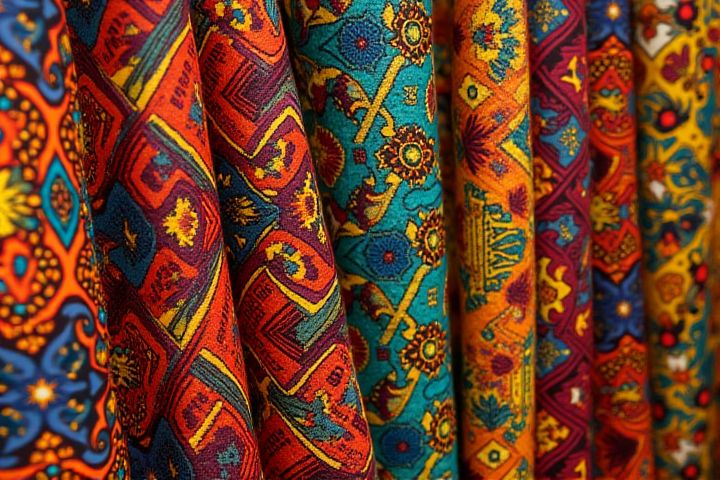
Nigeria's textile industry is rich in diversity, showcasing an array of colorful fabrics, intricate patterns, and traditional craftsmanship. Prominent textiles include Ankara, a wax-printed cotton fabric, often used for clothing and accessories, reflecting cultural heritage and local designs. The northern region is known for its traditional woven fabrics like Aso Oke, which holds significant cultural importance during ceremonies and celebrations. Natural fibers such as cotton and silk are commonly sourced from local farms, supporting sustainable practices and promoting the local economy. As you engage with Nigeria's textile landscape, you will discover vibrant markets, skilled artisans, and a thriving fashion scene that honors both tradition and innovation.
Traditional weaving techniques
Traditional weaving techniques in Nigeria showcase a rich cultural heritage, with artisans employing methods passed down through generations. Local materials such as cotton and fibers are skillfully transformed into vibrant fabrics, including Aso Oke, which holds significant social and ceremonial value. Regions like the North, particularly the Yoruba and Igbo communities, are renowned for their intricate patterns and unique dyeing methods, including indigo and adire. Engaging with this textile tradition not only supports local economies but also preserves the artistry and identity of Nigerian craftsmanship.
Aso-Oke fabric
Aso-Oke fabric, a traditional handwoven textile, is a significant part of Nigeria's cultural heritage, particularly among the Yoruba people. This vibrant fabric is often used in special ceremonies such as weddings and religious celebrations, showcasing intricate patterns and striking colors that reflect Nigerian artistry. The production process involves skilled artisans who utilize time-honored techniques and locally sourced materials, enhancing the fabric's authenticity and value. By incorporating Aso-Oke into your wardrobe, you not only embrace a unique style but also support local craftsmen and preserve a vital aspect of Nigerian culture.
Adire dyeing process
Adire is a traditional Nigerian textile art form, renowned for its unique dyeing process that utilizes natural ingredients to create vibrant patterns. Derived from the Yoruba culture, this technique involves folding, twisting, or stitching cloth before submerging it in dye, allowing artisans to produce intricate designs that tell stories and reflect cultural heritage. The dyes are often made from locally sourced plants and indigo, showcasing the region's rich botanical diversity. By engaging in Adire production, local communities not only preserve their artistic traditions but also promote sustainable practices and economic development.
Ankara prints
Ankara prints, celebrated for their vibrant colors and intricate patterns, dominate the textile landscape in Nigeria, reflecting a rich cultural heritage. These cotton fabrics are not only popular for everyday wear but also serve as a medium for storytelling, often depicting historical and social narratives. Artisans and designers creatively incorporate Ankara fabrics into modern fashion, merging traditional aesthetics with contemporary styles. You can find these textiles in various forms, from clothing to home decor, showcasing Nigeria's unique identity and artistic expression.
Cultural significance in clothing
Textiles in Nigeria hold deep cultural significance, reflecting the rich heritage and diversity of its various ethnic groups. Each region showcases unique patterns, colors, and weaving techniques, with materials such as Aso Oke, Kente, and Adire symbolizing specific traditions and ceremonies. Clothing made from these fabrics often serves not only as everyday wear but also as a marker of social identity, status, and cultural pride during important events like weddings and festivals. Understanding the intricate connection between Nigerian textiles and cultural practices enhances your appreciation of this vibrant art form and its role in preserving history.
Growing textile industry
The Nigerian textile industry is experiencing significant growth, driven by both local production and export opportunities. With a rich history of indigenous weaving techniques and vibrant patterns, the country is reclaiming its position as a hub for textile manufacturing in West Africa. Government initiatives and investments in technology aim to enhance the quality and competitiveness of Nigerian textiles in global markets. As you explore this evolving landscape, you'll discover innovative designs that reflect Nigeria's cultural heritage, appealing to both domestic consumers and international buyers alike.
Import and export dynamics
The textile industry in Nigeria plays a crucial role in the country's economic landscape, revolving around the dynamics of import and export. Nigeria primarily imports fabric and finished textile products to meet domestic demand, but there is a growing emphasis on boosting local production to reduce dependency on foreign goods. The export of Nigerian textiles, including traditional fabrics like Aso Oke and Ankara, has gained traction, showcasing the rich cultural heritage while also contributing to foreign exchange earnings. By investing in modern manufacturing techniques and sustainable practices, you can help foster a robust textile sector that enhances Nigeria's global trade position.
Government support initiatives
The Nigerian textile industry is significantly impacted by various government support initiatives aimed at promoting local production and reducing import dependency. Programs such as the Nigerian Economic Sustainability Plan (NESP) emphasize job creation and skill development within the textile sector. Additionally, financial incentives and grants are provided to manufacturers to encourage investment in sustainable practices and modernization of facilities. By prioritizing local sourcing and production, these initiatives contribute to the overall growth and resilience of the Nigerian economy.
Challenges facing the sector
The Nigerian textile sector faces significant challenges, primarily due to competition from imported fabrics, which undermines local production efforts. Outdated machinery and production techniques further hinder efficiency and quality, resulting in a decline in global competitiveness. Insufficient access to financing limits investment in modernization and innovation, crippling the potential for growth. Additionally, inadequate infrastructure, such as unreliable power supply and poor transportation networks, exacerbates operational difficulties for textile manufacturers across the country.
Sustainability efforts
Nigerian textiles are increasingly emphasizing sustainability through the use of organic materials and eco-friendly dyes. Local artisans are integrating traditional techniques with modern approaches, reducing reliance on synthetic fibers and promoting handmade production. This shift not only supports the environment but also uplifts local economies by providing fair wages to artisans. By choosing sustainable textiles, you contribute to a growing movement that values ethical production and environmental responsibility.
